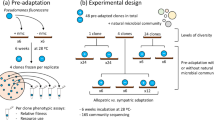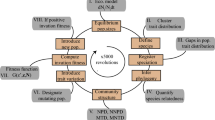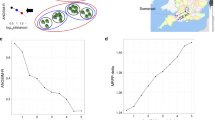Abstract
The relationship between biodiversity and ecosystem functioning (BEF) has become a cornerstone of community and ecosystem ecology1,2,3 and an essential criterion for making decisions in conservation biology and policy planning4,5. It has recently been proposed that evolutionary history should influence the BEF relationship because it determines species traits and, thus, species’ ability to exploit resources6,7. Here we test this hypothesis by combining experimental evolution with a BEF experiment. We isolated 20 bacterial strains from a marine environment and evolved each to be generalists or specialists8. We then tested the effect of evolutionary history on the strength of the BEF relationship with assemblages of 1 to 20 species constructed from the specialists, generalists and ancestors9. Assemblages of generalists were more productive on average because of their superior ability to exploit the environmental heterogeneity10. The slope of the BEF relationship was, however, stronger for the specialist assemblages because of enhanced niche complementarity. These results show how the BEF relationship depends critically on the legacy of past evolutionary events.
This is a preview of subscription content, access via your institution
Access options
Subscribe to this journal
Receive 51 print issues and online access
$199.00 per year
only $3.90 per issue
Buy this article
- Purchase on Springer Link
- Instant access to full article PDF
Prices may be subject to local taxes which are calculated during checkout



Similar content being viewed by others
References
Kinzig, A. P., Pacala, S. & Tilman, G. D. (eds) The Functional Consequences of Biodiversity: Empirical Progress and Theoretical Extensions (Princeton Univ. Press, 2002)
Loreau, M., Naeem, S. & Inchausti, P. (eds) Biodiversity and Ecosystem Functioning: Synthesis and Perspectives (Oxford Univ. Press, 2002)
Naeem, S., et al. Biodiversity, Ecosystem Functioning, and Human Wellbeing: An Ecological and Economic Perspective (Oxford Univ. Press, 2009)
Srivastava, D. S. & Vellend, M. Biodiversity-ecosystem function research: is it relevant to conservation? Annu. Rev. Ecol. Evol. Syst. 36, 267–294 (2005)
Duffy, J. E. Why biodiversity is important to the functioning of real-world ecosystems. Front. Ecol. Environ. 7, 437–444 (2009)
Cadotte, M. W., Cardinale, B. J. & Oakley, T. H. Evolutionary history and the effect of biodiversity on plant productivity. Proc. Natl Acad. Sci. USA 105, 17012–17017 (2008)
Cadotte, M. W., Cavender-Bares, J., Tilman, D. & Oakley, T. H. Using phylogenetic, functional and trait diversity to understand patterns of plant community productivity. PLoS ONE 4, e5695 (2009)
Barrett, R. D. H., MacLean, R. C. & Bell, G. Experimental evolution of Pseudomonas fluorescens in simple and complex environments. Am. Nat. 166, 470–480 (2005)
Bell, T. et al. The contribution of species richness and composition to bacterial services. Nature 436, 1157–1160 (2005)
Loreau, M. Microbial diversity, producer-decomposer interactions and ecosystem processes: a theoretical model. Proc. R. Soc. Lond. B 268, 303–309 (2001)
Tilman, D., Lehman, C. L. & Thomson, K. T. Plant diversity and ecosystem productivity: theoretical considerations. Proc. Natl Acad. Sci. USA 94, 1857–1861 (1997)
Loreau, M. Biodiversity and ecosystem functioning: a mechanistic model. Proc. Natl Acad. Sci. USA 95, 5632–5636 (1998)
Diaz, S. & Cabido, M. Vive la difference: plant functional diversity matters to ecosystem processes. Trends Ecol. Evol. 16, 646–655 (2001)
Reiss, J., Bridle, J. R., Montoya, J. M. & Woodward, G. Emerging horizons in biodiversity and ecosystem functioning research. Trends Ecol. Evol. 24, 505–514 (2009)
Venail, P. A. et al. Diversity and productivity peak at intermediate dispersal rate in evolving metacommunities. Nature 452, 210–214 (2008)
Levins, R. Evolution in Changing Environments: Some Theoretical Considerations (Princeton Univ. Press, 1968)
Futuyma, D. J. & Moreno, G. The evolution of ecological specialization. Annu. Rev. Ecol. Syst. 19, 207–233 (1988)
Kassen, R. The experimental evolution of specialists, generalists, and the maintenance of diversity. J. Evol. Biol. 15, 173–190 (2002)
MacLean, R. C. Adaptive radiation in microbial microcosms. J. Evol. Biol. 18, 1376–1386 (2005)
Buckling, A., Maclean, R. C., Brockhurst, M. A. & Colegrave, N. The Beagle in a bottle. Nature 457, 824–829 (2009)
Tilman, D. et al. Diversity and productivity in a long-term grassland experiment. Science 294, 843–845 (2001)
Cardinale, B. J. et al. Impacts of plant diversity on biomass production increase through time because of species complementarity. Proc. Natl Acad. Sci. USA 104, 18123–18128 (2007)
Stachowicz, J. J., Graham, M., Bracken, M. E. S. & Szoboszlai, A. I. Diversity enhances cover and stability of seaweed assemblages: the role of heterogeneity and time. Ecology 89, 3008–3019 (2008)
MacLean, R. C., Bell, G. & Rainey, P. B. The evolution of a pleiotropic fitness tradeoff in Pseudomonas fluorescens . Proc. Natl Acad. Sci. USA 101, 8072–8077 (2004)
Salles, J. F., Poly, F., Schmid, B. & Le Roux, X. Community niche predicts the functioning of denitrifying bacterial assemblages. Ecology 90, 3324–3332 (2009)
Bell, T. et al. A linear model method for biodiversity-ecosystem functioning experiments. Am. Nat. 174, 836–849 (2009)
Yachi, S. & Loreau, M. Biodiversity and ecosystem productivity in a fluctuating environment: the insurance hypothesis. Proc. Natl Acad. Sci. USA 96, 1463–1468 (1999)
Abrams, P. A. Adaptive change in the resource-exploitation traits of a generalist consumer: the evolution and coexistence of generalists and specialists. Evolution 60, 427–439 (2006)
Balvanera, P. et al. Quantifying the evidence for biodiversity effects on ecosystem functioning and services. Ecol. Lett. 9, 1146–1156 (2006)
Bell, T. et al. in Biodiversity, Ecosystem Functioning and Human Well-being (eds Naeem, S. et al.) 121–133 (Oxford Univ. Press, 2009)
Lane, D. J. in Nucleic Acid Techniques in Bacterial Systematics (eds Stackebrandt, E. & Goodfellow, M. ) 115–147 (Wiley, 1991)
Ewing, B. & Green, P. Base-calling of automated sequencer traces using phred. II. Error probabilities. Genome Res. 8, 186–194 (1998)
Ashelford, K. E. et al. New screening software shows that most recent large 16S rRNA gene clone libraries contain chimeras. Appl. Environ. Microbiol. 72, 5734–5741 (2006)
Maidak, B. L. et al. A new version of the RDP (Ribosomal Database Project). Nucleic Acids Res. 27, 171–173 (1999)
Pruesse, E. et al. SILVA: a comprehensive online resource for quality checked and aligned ribosomal RNA sequence data compatible with ARB. Nucleic Acids Res. 35, 7188–7196 (2007)
Altschul, S. F. et al. Gapped BLAST and PSI-BLAST: a new generation of protein database search programs. Nucleic Acids Res. 25, 3389–3402 (1997)
Bochner, B. R. Sleuthing out bacterial identities. Nature 339, 157–158 (1989)
Bouvier, T., del Giorgio, P. A. & Gasol, J. M. A comparative study of the cytometric characteristics of high and low nucleic-acid bacterioplankton cells from different aquatic ecosystems. Environ. Microbiol. 9, 2050–2066 (2007)
Acknowledgements
We thank T. Barraclough, G. Bell, M. Loreau, R. C. MacLean and A. Paquette for comments on earlier versions of the manuscript. This work was supported by a fellowship from the Natural Sciences and Engineering Research Council of Canada and a research grant from the Canada Research Chair Program, to D.G., and research grant ANR-09-JCJC-0110-01, to N.M.
Author information
Authors and Affiliations
Contributions
D.G., T. Bell, C.B., T. Bouvier, T.P., P.V. and N.M. designed the research; D.G., C.B., T.P., P.V., T. Bell and N.M. conducted the research; and D.G., T. Bell and N.M. contributed to the model, analytical tools and wrote the manuscript. D.G., T. Bell, C.B., T. Bouvier, T.P., P.V. and N.M. edited the manuscript.
Corresponding authors
Ethics declarations
Competing interests
The authors declare no competing financial interests.
Supplementary information
Supplementary Information
This file contains Supplementary Material 1 - 9 which includes Supplementary Data and Methods, additional references, Supplementary Figures and Supplementary Tables. (PDF 3369 kb)
Supplementary Data 1
This file contains the Supplementary Data. (TXT 4 kb)
Rights and permissions
About this article
Cite this article
Gravel, D., Bell, T., Barbera, C. et al. Experimental niche evolution alters the strength of the diversity–productivity relationship. Nature 469, 89–92 (2011). https://doi.org/10.1038/nature09592
Received:
Accepted:
Published:
Issue Date:
DOI: https://doi.org/10.1038/nature09592
This article is cited by
-
Coexistence of specialist and generalist species within mixed plastic derivative-utilizing microbial communities
Microbiome (2023)
-
Niche dimensions of a marine bacterium are identified using invasion studies in coastal seawater
Nature Microbiology (2021)
-
Species identity drives ecosystem function in a subsidy-dependent coastal ecosystem
Oecologia (2021)
-
Coexistence of plant species under harsh environmental conditions: an evaluation of niche differentiation and stochasticity along salt marsh creeks
Journal of Ecology and Environment (2020)
-
Community-level signatures of ecological succession in natural bacterial communities
Nature Communications (2020)
Comments
By submitting a comment you agree to abide by our Terms and Community Guidelines. If you find something abusive or that does not comply with our terms or guidelines please flag it as inappropriate.



